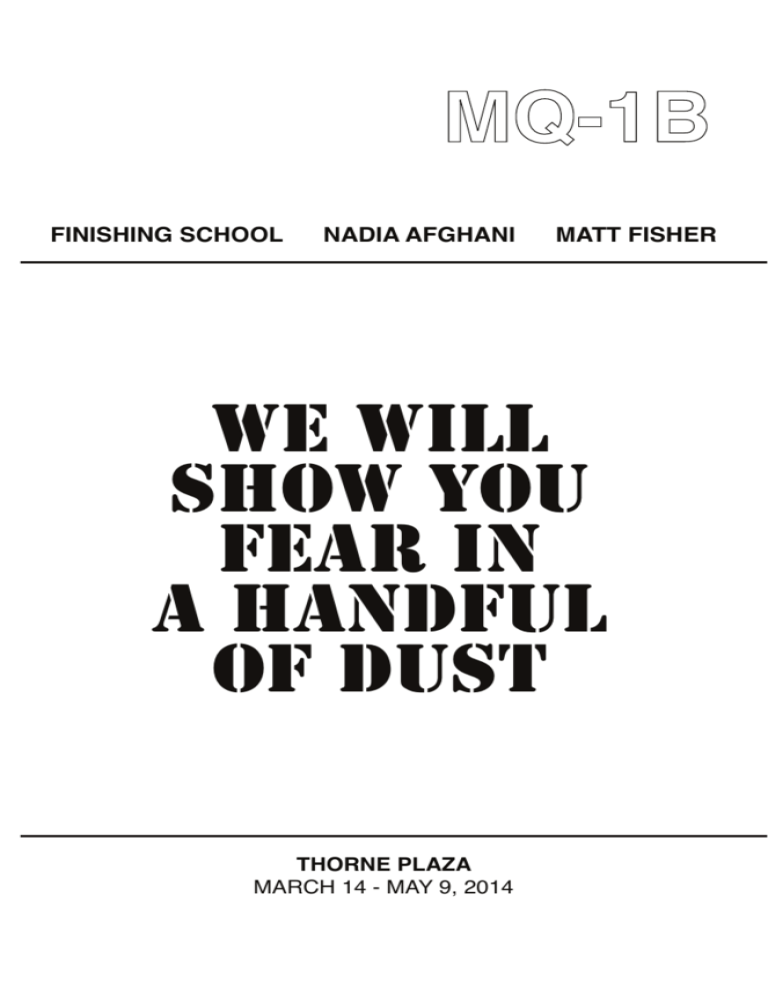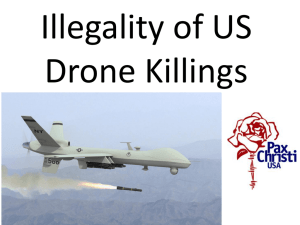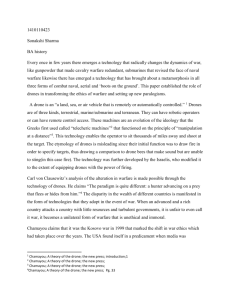- Finishing School
advertisement

FINISHING SCHOOL NADIA AFGHANI MATT FISHER WE WILL SHOW YOU FEAR IN A HANDFUL OF DUST THORNE PLAZA MARCH 14 - MAY 9, 2014 “If you do something for long enough, the world will accept it. The whole of international law is now based on the notion that an act that is forbidden today becomes permissible if executed by enough countries . . . International law progresses through violations.” —Colonel Daniel Reisner, former head of the Isreali Defense Forces Legal Department Meet Your Predator Remotely piloted, capable of long flight times, and armed with two Hellfire AGM-114 missiles, the Predator MQ-1B is designed for what the Air Force euphemistically calls “irregular warfare” operations against “high-value, fleeting, and time-sensitive targets.” By now we all understand that “irregular warfare” means “legally ambiguous” and that those “high-value targets” are people, some of them suspected terrorists, many of them not. The military refers to the Predator as a system, and it is fairly evident why: it takes two remote split operations groups working cooperatively to operate a Predator. A minimal forward ground crew manages takeoff and landing from somewhere within the Predator’s 700-mile flight range, and a team of two or more remotely pilots the drone and fires its missiles via satellite link, most often by joystick in front of video monitors a few thousand miles away at either a Virginia CIA facility or Nevada Air Force base. With this in mind, the Predator aircraft is only the mechanical extremity of a highly interconnected cultural and technological network of systems. In order to pin down the meaning or function of a weapon like the Predator, we necessarily must attempt to account for the abstract structures—the political, financial, cultural and technological machinery—that determine its overall purpose and significance. In this way, we can treat the Predator as a metonymic abstraction or interface into the systems of which it is both a member and an index. As a convenient term, we’ve adopted the coinage of technology theorist Lewis Mumford, who called this assemblage of living and technological machinery a technics. In envisioning a technics, Mumford allows no privileging distinction between human, social or mechanical constituent parts or operations, and therefore you can’t separate a weapon’s form or purpose from the technics that gives it both function and meaning. “We Will Show You Fear in a Handful of Dust” utilizes the fabrication of a replica of a Predator drone aircraft to trigger an investigation of this particular weapon’s technics, with the aim of proposing and modeling a possible act of resistance to the authoritarian machinery that powers it. Regimes of dehumanized killing As a generalization, drones do not target heads of state or commanders of conventional military forces. But then, the assignment of targets to the kill list is a matter of top-secret, judicially unreviewable deliberations. Still, the proceedings ostensibly adhere to international agreements that allow such killing in the face of imminent threat to the United States. ‘Ostensibly’ since there is yet no oversight into how that determination of threat is made, and the overwhelming anecdotal evidence demonstrates that most drone strike victims exhibit only a tenuous apparent connection to terrorist activity or threats toward the U.S. Further, among the victims are U.S. citizens who have been executed without Constitutionally-granted due process. The apparent restraints of international war codes have already been bent and reconfigured to to the point of nonexistence, and the Obama administration repeatedly asserts its right to redefine “imminent threat” in terms most congenial to this Tuesday’s kill list. The list of planned drone strikes is subdivided into “personality strikes” (attacks on specific individuals from the kill list) and “signature strikes” (attacks on unknown individuals who will appear to fit the profile of enemy combatants). The bulk of drone strikes in Pakistan, Afghanistan and Yemen thus far have been signature strikes with the identities, not to mention the activities, of the dead mostly left undetermined. To be targeted and killed by a strike is to be assigned the unusual, vague legal status of already having been presumed to be an imminent threat. To be clear, this final assignment of identity and presumed guilt happens retroactively after the kill. The Bush-Obama policy classifies all military-age males in a strike zone as combatants, but that determination becomes relevant only later, upon counting bodies. The essential ambiguity of execution by drone is in the nonstatus of being neither civilian nor combatant. To be killed by drone is to be made the Other, an act that strips the victim of status and humanity. The essential formal property of the drone strike, and the thing that sets it apart from other kinds of military assassinations, is that each strike (called a “tap” in the jargon) is carefully designed and executed to be but one in a repeatable series of strikes. Assassination in the age of mechanical reproduction. Whereas by comparison political assassinations are carefully calibrated against their post-kill ramifications, and invasions or occupations are weighed against the logistic investments needed to control cities and territories wrested, each drone tap serves more than anything as an identically reproducible event in an indefinite series of future taps. The social function of a drone kill is already always not just a theatrical declaration of potency, but also a warning and precursor to other strikes. Part of the gamification of killing that characterizes the drone warfare era—its specificity, anonymity, dehumanization, and repeatability—is that there is always a new weekly list of targets to assassinate. Tap tap tap. In this way, the function of the Predator is as exterminating agent for an unaccountable, secretive, and dehumanizing authoritarian technics. The global killing jar The drone warfare era introduces a novel element into the classical military equation that positions strategy against tactics. The conventional distinction being that strategy is primarily concerned with long-term control of a terrain—a territory, city, facility, feature, or border—while tactics are mobile, usually guerrilla, actions executed irrespective of holding fixed points of ground. As a general corollary, strategic operations are necessarily public and theatrical — visible displays of potency and control over public spaces are hallmarks of holding terrain and a main strategic activity of the state. Tactical maneuvers tend toward the covert, since they always risk exposing fleeting or groundless positions. The drone upends this conventional military discourse because it is essentially a groundless tactical weapon that exerts a complete theatrical control of the ground—a sort of hybrid. The Predator, and drones like it, acts as a zero degree of abstraction in the surveillance war machine, and as such, the Predator accomplishes a radical shift in redefining public spaces. To better explain, it is helpful to draw comparison between military strike drones and two other weapons systems: the sniper and the nuke. Snipers are the ultimate private, tactical killers, and rely heavily on networks of intelligence and surveillance. The sniper stalks its target methodically and patiently, becoming familiar with its routine, its body, and points of vulnerability. The immediate aim of the sniper isn’t to seize an asset or control a space, it is to extract and eliminate a specific, high-value human actor from the equation of the current objective. A sniper may kill a target in broad daylight in a town square, but does so from an inherently temporary and fleeting position. Insofar as the sniper stalks and hunts a specific human target, each sniper kill is unique and nuanced. The nuke, on the other hand, is the bluntest, most absurdly public weapon currently imaginable. Thermonuclear detonations render any particularities of cultural, political and local texture at the target locale utterly immaterial and irrelevant, and deafly refuse to differentiate between biological, technological, or environmental carnage. As such, the nuke is the ultimate theatrical weapon, and operates in the most hyperbolic milieu of political brinkmanship. The threat of nuclear war depends entirely on a specific notion of an encompassing public identity and common terrain. A nuclear bomb doesn’t kill one person, it kills all of us. The structural formal characteristic that connects the sniper and the nuke is their relationship to the public and public space, for which they each have ancient antecedents—whether the totalizing destruction of the natural disaster or the secret execution by assassin’s knife. Drone surveillance killing injects a new element unique to the age of global panoptic intelligence. The killer drone hybridizes the tactical specificity and intimacy of the sniper’s surveillance kill with the public, strategic theatricality of the nuke. Drones like the Predator are dispatched to kill specific individuals wherever they may be located in the most dramatic, public way possible, by raining down sudden death from the sky. In that way, the differentiation between killer drones and these other weapons is in its reforming ability to reshape the concept of a public space. Under the drone’s exterminating gaze, all physical terrain and public spaces in the field of play now belong to the controlling regime. The drone is the ultimate icon and metonymic abstraction for the military surveillance state; it is a depersonal, remotely controlled killer that combines monitoring and destroying in a single activity. To be sure, this unique status relies on the drone’s larger, enabling authoritarian technics — most notably the state’s coercive regime that leverages financial, political and diplomatic assets to create a freely penetrable airspace for drone surveillance and operations — which allows the drones supremacy over an incontestable position from the sky. As metonym for a global system of surveillance and intimidation, death by drone strike is the ultimate panoptic event, one which extends the estrangement of Otherness to any and all potential victims, wherever the expanding shroud of U.S. -controlled airspace allows, whether over domestic or foreign terrain. It collapses the distance between public and intimate, between paranoia and conflict. The ultimate aim of the state’s war machine has always been to circumscribe the entire globe within the abstract death video game, with all cartesian points located within the killing jar, the particularities and messy logistics of holding ground no longer a factor. Coupled with the secret and absurd, yet somehow accepted, unilateral agency of the administration to assassinate targets at will with no shred of due process, the message is: “All your space are belong to us.” Resistance and sculptural form “From late Neolithic times in the Near East, right down to our own day, two technologies have recurrently existed side by side: one authoritarian, the other democratic, the first system-centered, immensely powerful, but inherently unstable, the other [hu]man-centered, relatively weak, but resourceful and durable.” —Lewis Mumford, “Authoritarian and Democratic Technics” Mumford again, who was most concerned with the rise to power of various totalitarian powers in the 20th century, and so his positioning of two regimes of technics moralizes a distinction between small, democratic ones and the larger authoritarian, state-controlled megamachines (his term) which tend to subsume them. But this process of capture and assimilation is no sure thing. Where there are regimes of power, there are always sites of resistance and escape. When invoking ideas about the authoritarian state, the concept of a public and publicness is always near at hand, since regulating and controlling public spaces and identities is one of the main ways the state regulates people. This is a good point to acknowledge that public is a term that converges multiple meanings, and the way we use it regards public both as an adjective that describes socially accessible and commonly regarded spaces (public discourse, public space) and also as a noun—borrowing the usage of theorist Michael Warner—that reflects a self-organized relation among strangers created by the circulation of discourse, a crowd witnessing itself in a public space (a public, the public). All authoritarian technics are inherently unstable since they require the perceived estrangement and powerlessness of contra-positioned discourses as a condition of their power. In slightly plainer English, the state requires that the public believe that it is only a public, a minor and relatively powerless part of another, vaguer body that is somehow more enfranchised. Public space is the main locus for this dynamic, unstable battle of perception. If where the public and public space interact is a particular context for state dominance and assimilation (and if we can use the form of a Predator as a metonymic interface herein), then it is also the most vitally prized site for acts of resistance and subversion (and we can make a response that uses that interface as a starting point). Experimenting with the contraposition of two technologies that Mumford describes, “We Will Show You Fear in a Handful of Dust” enlists and activates a resourceful, democratic technics to enter the fray. Talk value Anything that is or has a space also has a number of socio-sculptural forms that can be interrogated and messed with. So, the experimental aim of “We Will Show You Fear in a Handful of Dust” is to stack, conflate and interposition several kinds of these forms: 1. The sculptural form of our drone, along with the narrative associations that attend it. We directly intend our drone to get in your way. After all, it’s 55 feet wide. It’s easily large enough to be spotted by drones surveilling campus, in fact. We used a fairly exact computer model as the basis of our drone. But we were not interested in replicating it precisely. We were more interested in hybridizing a technological mode of production — the subtractive CNC process used to fabricate the core armature of our drone — with an age old, collaborative construction technique that has been used all over the planet for centuries. We expect you to notice that this drone cannot move or fly. It has been weighed down and anchored to the earth. We think you’ll see that while it may have a core armature that is fabricated in an exact manner by machines, its outer layer is a coating of earth that is mixed and applied imprecisely by hand. We intend you to recall how other things are often coated in earth, among them the homes and buildings in most traditional Eurasian villages. Things are also interred in the earth as they are buried. We expect that other associations we didn’t originally start with will enter into circulation. Among them: that other items made from clay or mud are fabricated specifically to be targets for practice; that Occidental is only a few miles from many of the the locations where James Cameron’s The Terminator was filmed, a film which also featured a robot killer encased in a fragile, fallible shell; that other figures of earth—nkondi, golems, and others—have historically and mythically held important social functions in warding off evil or injuring assailants; that the famous quote attributed to Einstein warns us that the progression of warfare will lead us all back to the stone age; and other associations not listed here. 2. The form of the public, collaborative effort to assemble and finish our drone. The participatory call and assembling of volunteers is a performative model for the kind of democratic technics that Mumford describes. We could have delivered and installed a completely finished sculpture. It would have appeared one day and been assembled in the usual manner (safety cordons, pylons) that isolates so-called public sculpture from its public. Instead we chose to enlist a crowd of strangers to help us mix and apply the final coating of architectural grade mud to our drone. In that way this project consists of, along with making a sculpture of a drone, modeling making a public of a particular nature. To be sure, all the people who physically or virtually view and respond to our drone are its public, the same way as with any work of art. But without the collaborative effort and the unquantifiable interactions that come with that, this would have been a different project altogether. To make a public, you set into circulation a body of discourse that strangers will reflexively recognize, modify and recirculate it. Relative to the statedefined normative acquiescence to our national, authoritarian policies that govern our drone warfare program, we are not assembling the public, rather a smaller, necessarily subordinate counterpublic that exists temporarily in specific relation to this project. 3. The formal relationship between the sculpture and the particular public that will interact with it It is no accident that we pursued the installation of this drone at Occidental as a specific site. Any more upstream would be the White House lawn, but it is better here. The democratic call, assembly, and participation by this particular counterpublic that is needed to ultimately transform our drone’s machined armature into something made more unevenly and imprecisely by individuals is an important site for discursive circulation, and the heart of this piece. To engage and incriminate a technics it is not enough to produce a sculpture that sits isolated or is part of state-controlled norms of protest. And the audience for this work is not the administration, it is the counterpublic that will help assemble it and create the discourse around it. That discourse isn’t singular nor dictated by us. In fact, much of it will be undisclosed to us. It is a multiplicity of impressions, reactions, memories, and conclusions that carry multiple readings across the varying constituencies that we hope will extend the social circulation of our public’s space. Much of the circulating discourse will be created and passed around in terms we have not thought of, in language patterns we did not imagine, in ways particular to specific contexts that we are not directly part of. 4. The formal relationship of positioning (flaunting) this activity as part of an ongoing body of social practice. When it comes right down to it, Finishing School does not primarily make objects; we make occurrences that naturally utilize rarified objects as a point of departure. More precisely, we orchestrate models of interaction that poke at and penetrate accepted state-derived norms of acquiescence and control. More often than not, what we try to do is propose a kind of publicmaking and then flaunt it. The way it’s used here, flaunting is a kind of specialized term specific to counterpublics that denotes inverting public and private. Counterpublics articulate themselves with and through discourse. They model possible kinds of circulating communication — informally derived, usually hermetic — that are outside or underneath the gaze of larger, more authoritarian technics. A flaunt is always that private joke made public and formal, in a way that is similar to what Michel Foucault called a “performance criticism.” To flaunt a public-making involves using the subordinate status of a counterpublic as the origin of a discourse that can then be turned outward as a charged form of critique. One of the defining characteristics of the particular field of social practice that we work in is the regard of publicness, public identity, and public spaces as a field of aesthetics with formal political, architectural, ethical, and social dimensions. The history of our tactical media and interventionist practice deals particularly with a specialized discursive model that repeatedly attempts to find novel ways to propose alternative or contesting ways to create, interrupt, or scramble public identities within public spaces. Acknowledgements “We Will Show You Fear in a Handful of Dust” is made possible by the Wanlass Artist in Residence Program, which is supported by the Kathryn Caine Wanlass Foundation. To them we we are grateful for the opportunity to present this project to the Occidental College campus and the larger community. We are also grateful for the generous support provided by the Remsen Bird Fund. We would also like to thank the faculty and staff of Occidental College. We also are extremely thankful for Steve Ross and his team at Foam Concepts their partnership in this project. And to Aandrea Stang, our friend, curator, mentor, sister, and collaborator, your continued dedication and support to our practice has helped us in ways that are difficult to summarize in words. We love you and thank you. To our own friends, families, and colleagues, thank you for your endless support and love.




